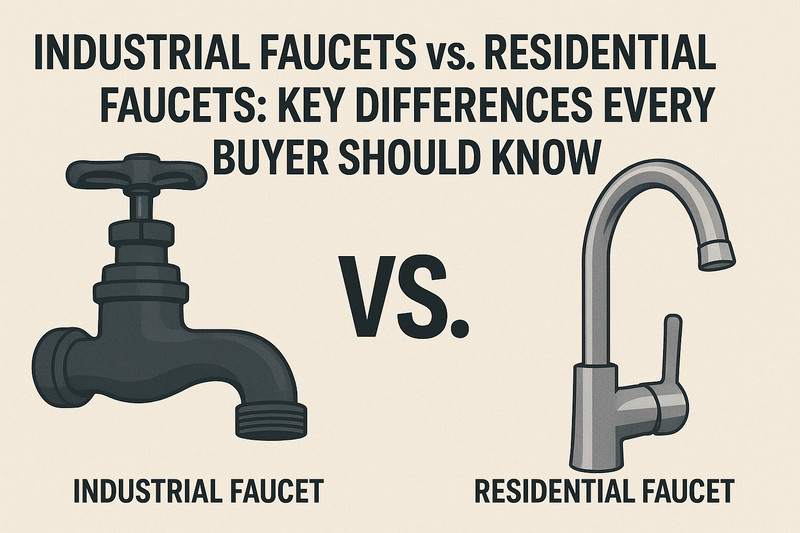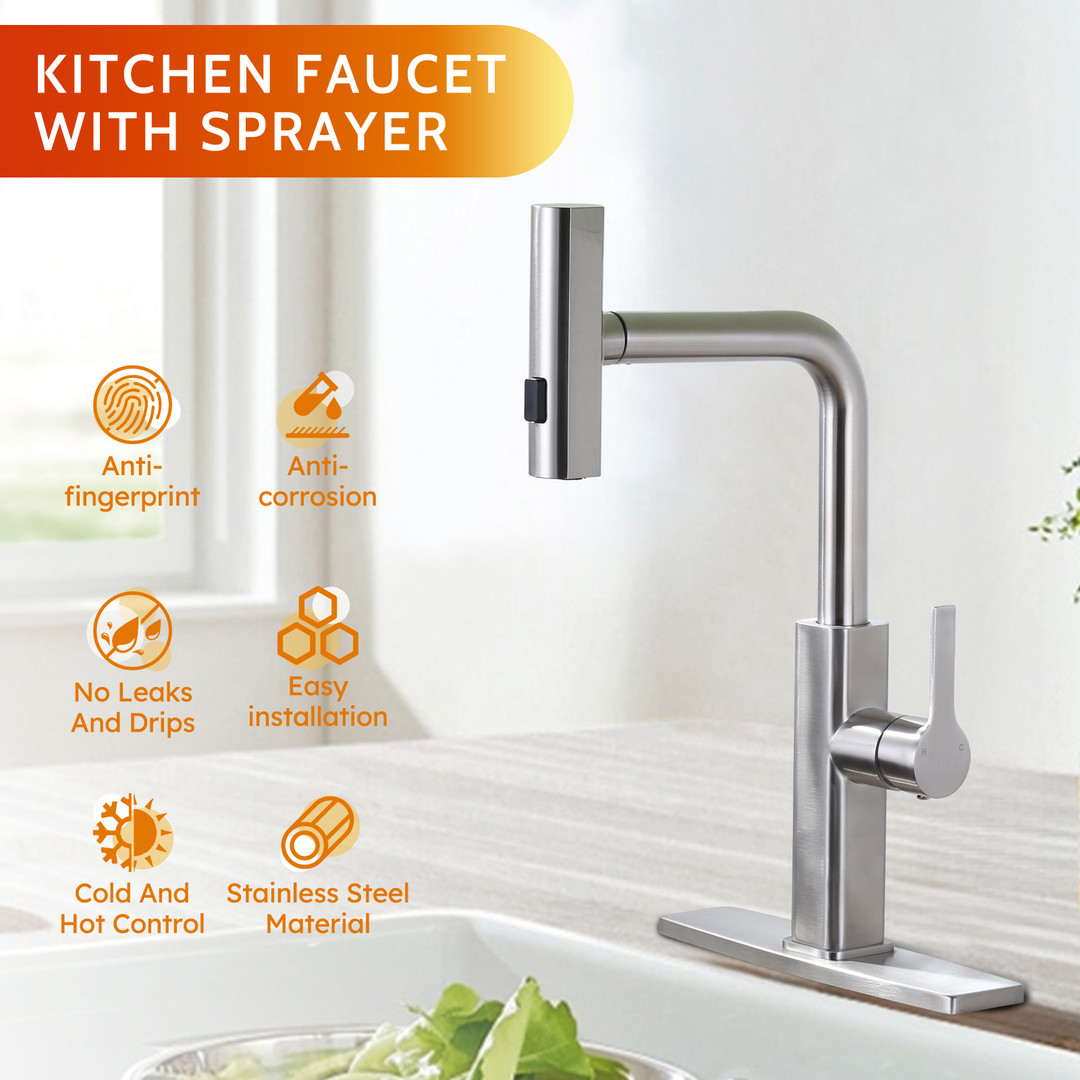Industrial Faucets vs. Residential Faucets: Key Differences Every Buyer Should Know
Views:85 classificationBlog classificationFaucet Knowledge

When most people think about faucets, they picture the sleek chrome fixture in their kitchen or bathroom. However, not all faucets are built for the same purpose. In fact, the faucet you use at home is very different from the one you’d find in a commercial kitchen, factory, or laboratory. Industrial faucets and residential faucets may serve the same basic function—delivering water—but the design, materials, performance, and maintenance needs vary significantly.
If you’re considering upgrading your home faucet, setting up a commercial kitchen, or simply curious about the differences, this article breaks down everything you need to know about industrial faucets vs. residential faucets.
1. Purpose and Application
The most obvious difference lies in where the faucets are used.
-
Industrial Faucets are built for heavy-duty applications in commercial kitchens, factories, medical facilities, schools, and laboratories. They must withstand constant use, high water flow, and, in many cases, exposure to harsh cleaning agents. Their design is focused on durability and efficiency rather than style.
-
Residential Faucets are designed for home kitchens, bathrooms, and laundry rooms. They prioritize style, convenience, and water efficiency. While durability is important, residential faucets are not expected to endure the same level of daily stress as industrial models.
2. Materials and Construction
The materials used in each type of faucet reflect the environments they’re built for.
-
Industrial Faucets typically use heavy-duty brass, stainless steel, or chrome-plated brass. These materials are resistant to corrosion, chemicals, and extreme temperatures. Components like springs, joints, and valves are reinforced to withstand repeated use.
-
Residential Faucets may also use brass or stainless steel, but lighter alloys and decorative finishes like matte black, brushed nickel, or oil-rubbed bronze are common. The focus here is on aesthetic appeal as much as function.
In short, industrial faucets are about function and resilience, while residential faucets balance durability and design.
3. Design and Appearance
If you put an industrial faucet next to a residential faucet, the difference is immediately clear.
-
Industrial Faucets often have a tall, utilitarian design with features like spring-loaded pull-down sprayers, dual handles, and extended spouts. Many resemble what you’d see in a professional restaurant kitchen—functional, powerful, and minimalistic in style.
-
Residential Faucets come in countless designs to match different interior styles, from traditional to modern. They may have curved spouts, touchless sensors, or decorative handles. The goal is to complement home décor while providing convenient water access.
4. Water Flow and Pressure
Performance is another major difference.
-
Industrial Faucets are engineered for high water flow rates to handle heavy cleaning tasks quickly. For example, a commercial kitchen may need to wash large pots and pans in seconds. Some industrial faucets are designed to handle high-pressure systems and continuous operation.
-
Residential Faucets usually have flow restrictors to conserve water. In many regions, faucets are limited to about 1.5–2.2 gallons per minute to meet water efficiency standards. While this is perfect for everyday household tasks, it wouldn’t be sufficient in an industrial setting.
5. Features and Technology
Both types of faucets have features, but they are tailored to their specific use.
-
Industrial Faucets may include:
-
Pre-rinse sprayers with high-pressure nozzles
-
Foot pedal or knee-operated controls (for hands-free use in kitchens or labs)
-
Extended reach spouts and swing arms
-
Multiple water lines for hot, cold, or filtered water
-
-
Residential Faucets may include:
-
Touchless or voice-activated technology
-
Pull-down or pull-out sprayers with adjustable spray modes
-
Built-in filtration systems
-
Decorative LED lighting or temperature indicators
-
Industrial faucets prioritize speed and efficiency, while residential faucets emphasize convenience and comfort.
6. Installation and Compatibility
-
Industrial Faucets are usually installed on heavy-duty sinks with multiple holes, reinforced mounts, and larger water supply lines. They often require professional installation, especially in restaurants or labs where compliance with health codes is necessary.
-
Residential Faucets are designed to fit standard kitchen or bathroom sinks, typically with one to four mounting holes. Many homeowners can install these themselves with basic tools.
7. Maintenance and Longevity
Because of their environments, maintenance requirements differ.
-
Industrial Faucets need frequent cleaning, inspection, and sometimes replacement of parts like washers or cartridges. However, they are designed for easy servicing, since downtime in a commercial setting is costly. When maintained properly, they can last many years under extreme use.
-
Residential Faucets generally require minimal upkeep—occasional cleaning, replacing aerators, or fixing minor leaks. Since they don’t face the same heavy stress, they often last a decade or more with little trouble.
8. Cost Comparison
Price is another area where the two differ.
-
Industrial Faucets are more expensive due to their size, materials, and heavy-duty construction. A basic industrial pre-rinse faucet might start around $300, with high-end models reaching $1,000 or more.
-
Residential Faucets have a wider price range, from budget models under $50 to luxury designer faucets costing several hundred dollars. The cost often depends on brand, finish, and technology.
9. Safety and Compliance
Industrial faucets must meet specific health, safety, and sanitation standards. For example, faucets in commercial kitchens often need NSF certification to comply with food safety regulations. Some also require ADA compliance for accessibility.
Residential faucets are usually tested for safety but are more focused on lead-free compliance and water conservation standards.
Conclusion: Choosing the Right Faucet
The choice between an industrial faucet and a residential faucet depends entirely on your needs.
-
If you’re running a commercial kitchen, laboratory, or any environment that demands constant, heavy use, an industrial faucet is the right investment. It offers durability, high water flow, and specialized features to keep up with demanding tasks.
-
For everyday household use, a residential faucet is the better choice. It’s affordable, stylish, easy to install, and designed to balance function with aesthetic appeal.
While both types ultimately deliver water, the difference lies in purpose, durability, and performance. Understanding these differences ensures you select the right faucet for your space, whether you’re cooking for a family of four or cleaning up after hundreds of customers in a busy restaurant.
 WEWE Kitchen Faucets
WEWE Kitchen Faucets

您好!please sign in